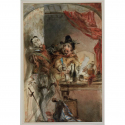The Paintings of James McNeill Whistler
m0168a
The assassination of the Duke of Buckingham

Date
The murder of a soldier is dated 1853.

The assassination of the Duke of Buckingham, Thomas Colbille Fine Art
It was done when Whistler was a cadet at the United States Military Academy at West Point. See Scenes from cadet life and Hugo or Dumas m0168.
Images

The assassination of the Duke of Buckingham, Thomas Colbille Fine Art
Subject
Description

The assassination of the Duke of Buckingham, Thomas Colbille Fine Art
It shows a cloaked man with a letter or document and another, more richly dressed, at left, with a dagger in his chest, and his sword leaning on the wall to left. The setting is an interior, lit by candlelight, with bottles and glasses on the table. A red curtain is looped up at upper right.
Sitter
This probably represents the assassination of George Villiers, 1st Duke of Buckingham (1592-1628) by the English soldier, John Felton (ca 1595-1628) in the Greyhound Pub at Portsmouth on 23 August 1628.
Whistler illustrated scenes from the novels of Alexandre Dumas (1802-1870). Loomis Lyman Langdon (1830-1910) recorded that 'The Three Guardsmen' (presumably meaning The Three Musketeers) as a favourite of Whistler. 1
Technique
Composition
A possible inspiration for the costume (as well as the subject) are wood-engravings of the murder of the Duke of Buckingham, in, for instance, the illlustrated edition of Les Trois Mousquetaires, Dufour et Moulat, Paris, 1851.
Technique
It appears that a sketching club was involved, in which Whistler was presumably joined by some of the other professionally trained draughtsmen and painters who attended West Point art classes under Robert Weir. A fellow cadet, Frances Laurens Vinton, could well have joined Whistler in this etching club; his work is similar in style. Maybe a competitive spirit was encouraged by the club, and led to the production of such highly developed paintings as Whistler’s.

The assassination of the Duke of Buckingham, Thomas Colbille Fine Art
The precision of Whistler’s brushwork, the treatment of detail (particularly of dress) and texture, and the vivid colour, are very striking.
Conservation History
The Doyle's auction catalogue of 8 May 2013 noted that it was glued at the corners to the back matting.
History
Provenance
- 1853: given by Whistler to a fellow West Point cadet, Alexander Stewart Webb (1835-1911).
- Date unknown: Arthur H. Hahlo & Co., New York art dealers.
- 2013: 'Property of a Greenwich Village Collector', sold at auction, Doyle’s sale of European, American, Modern & Contemporary Art, New York, 8 May 2013 (lot 253) as ‘A Confrontation’, and bought by Thomas Colville Fine Arts, New York.
Exhibitions
It was not, as far as is known, exhibited in Whistler's lifetime.
Bibliography
Catalogues Raisonnés
- None.
Books on Whistler
- Pennell, Elizabeth Robins, and Joseph Pennell, The Life of James McNeill Whistler, 2 vols, London and Philadelphia, 1908, vol. 2, pp. 308, 311-12.
Catalogues 1906-Present
- Doyle’s sale of European, American, Modern & Contemporary Art, New York, 8 May 2013 (lot 253) as ‘A Confrontation’.
Notes:
1: Pennell 1908 [more], vol. 2, pp. 308, 311-12.